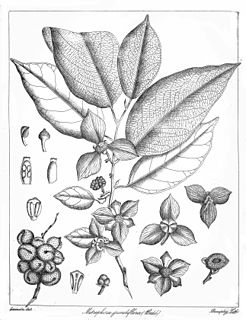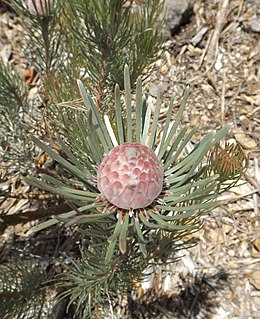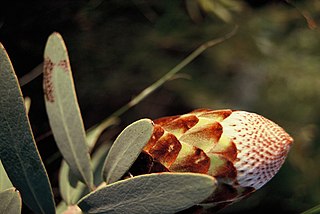
The genus Mitrephora, of family Annonaceae, comprises around 40 species of trees and shrubs found in tropical Asia and northern Australasia. The area of distribution extends from China in the North down to Queensland, Australia in the South. The genus is widely found in southern India and Southeast Asia. It reaches a maximum of diversity in Borneo and the Philippines.
Mitrephora caudata is a species of flowering plant in the family Annonaceae. It is endemic to the Philippines.
Mitrephora fragrans is a species of plant in the family Annonaceae. It is native to Borneo and The Philippines. Elmer Drew Merrill, the American botanist who first formally described the species, named it after its large, fragrant flowers.

Mitrephora grandiflora is a species of plant in the family Annonaceae. It is native to Karnataka and Kerala in India.
Mitrephora wangii is a species of plant in the family Annonaceae. It is native to China and Thailand.

Leucadendron album is a species of flowering plant in the family Proteaceae that grows in South Africa.
Grevillea molyneuxii, commonly known as the Wingello grevillea, is a shrub which is endemic to the shrublands of New South Wales in Australia.

Leucadendron laureolum, common names golden conebush and laurel leaf conebush, is a species of plant in the family Proteaceae. It is endemic to South Africa and also cultivated. It is a large bush that turns bright yellow in the winter flowering season.
Mitrephora samarensis is a species of plant in the family Annonaceae. It is native to the Philippines. Elmer Drew Merrill, the American botanist who first formally described the species, named it after Samar, the third largest island in the Philippines, where the sample he examined was collected.
Mitrephora weberi is a species of plant in the family Annonaceae. It is native to The Philippines. Elmer Drew Merrill, an American botanist, first formally described the species and named it after Charles Martin Weber who collected the specimen that Merrill examined.

Protea inopina, the large-nut sugarbush, is a flowering shrub belonging to the well-known Protea genus. The plant is endemic to the Western Cape, rare, extremely isolated and occurs only in the Olifants River mountains near Palace Hill.

Protea subulifolia, the awl-leaf sugarbush, is a flower-bearing shrub belonging to the Protea genus. The plant is native to the Western Cape and occurs from the Stettynskloof to Riviersonderendberge, Langeberg, Bot River to the Elim plain. The plant grows 50 cm in diameter and 70 cm tall and flowers from July to September.
Leucadendron cryptocephalum, the concealed conebush, is a flower-bearing shrub that belongs to the genus Leucadendron and forms part of the fynbos. The plant is native to the Western Cape and only two populations occur at Potberg and the Groenlandberg. There is little information available about the plant.

Spatalla curvifolia, the white-stalked spoon, is a flower-bearing shrub that forms part of the fynbos. The plant is native to the Western Cape, South Africa.
Serruria candicans, the shiny spiderhead, is a flower-bearing shrub that belongs to the genus Serruria and forms part of the fynbos. The plant is native to the Western Cape, where it occurs from Elandskloof to the Slanghoek Mountains and Paardeberg at Malmesbury. The shrub is erect and grows only 80 cm tall and bears flowers from July to December.
Paranomus adiantifolius, the hairy-style sceptre, is a flower-bearing shrub that belongs to the genus Paranomus and forms part of the fynbos. The plant is native to the Western Cape, South Africa.
Diastella myrtifolia, the Tulbagh silkypuff, is a flower-bearing shrub that belongs to the genus Diastella and forms part of the fynbos. The plant is native to the Western Cape and is found in the Groot Winterhoek. The shrub is erect to semi-erect with mat-shaped spreading branches.

Serruria collina, also known as the lost spiderhead, is a flower-bearing shrub that belongs to the genus Serruria and forms part of the fynbos. The plant is native to the Western Cape.
Spatalla caudata, the woolly-hair spoon, is a flower-bearing shrub that belongs to the genus Spatalla and forms part of the fynbos. The plant is native to the Western Cape where it is found in the Cederberg, Groot Winterhoek Mountains and Hex River Mountains.

Spatalla racemosa, the lax-stalked spoon, is a flower-bearing shrub that belongs to the genus Spatalla and forms part of the fynbos. The plant is native to the Western Cape where it is found in the Kogelberg, Groenlandberg, Babilonstoringberge, Kleinrivierberge as well as at Villiersdorp.









